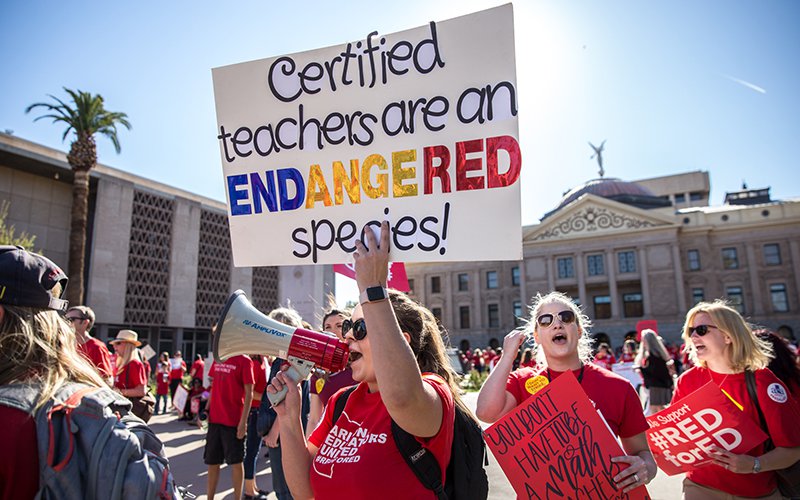Arizona schools started this academic year with a teacher shortage that saw 21 percent of all teaching positions vacant, and nearly half of the teachers who were on the payroll did not meet the state’s certification standards.
And that was an improvement from last year.
Those are the findings of an Arizona School Personnel Administrators Association survey of 150 school districts and charter schools, which reported 1,443 teaching slots remained open on Aug. 30, just a few weeks into the school year. In 2018, that number was more than 1,547.
The report was released last week, just 18 months after teachers staged statewide walkouts as part of the #RedforEd movement to protest the low pay for teachers and lack of resources for schools in the state. That led to approval of the 20×2020 plan, which promised to raise teacher salaries by 20% by the 2020-21 school year and make other improvements to school funding.
But many experts say it is not enough, and they called on state lawmakers to do more.
“While our state has made modest improvements, many of our classroom positions are vacant because our state has not done what is needed to attract and retain talented educators,” said Arizona Superintendent of Public Instruction Kathy Hoffman in a statement from her office. “If we simply continue down the path we’ve been on, we cannot expect different results.”
Heidi Vega, communications director for the Arizona School Boards Association, said the association was not surprised by the findings in the report, which she said is not due to a lack of available certified teachers – it is a lack of money.
“It’s not an issue of a teacher shortage but a funding shortage,” Vega said.
Schools in the survey said they have been forced to fill vacancies with long-term substitutes or student teachers without certification, among other quick fixes. In a statement accompanying the results, the administrators’ association called for increased school funding.
“The severe teacher shortage must be addressed,” the statement said. “Arizona’s leaders must make a collective effort to ensure the recruitment and retention of effective teachers through increased funding.”
A spokesman in Gov. Doug Ducey’s office said the administration is dedicated to improving the situation for teachers in the state.
“We know teachers are some of the biggest difference-makers in the lives of our students,” Ben Peterson, the spokesman, said in a statement. “That’s why Gov. Ducey has made it a priority to reward our hardworking teachers with pay raises and get more, qualified educators into the classroom.”
In addition to the 20×2020 program, Peterson pointed to the Arizona Teachers Academy, which funds future teachers’ final two years of school at any of the state’s three universities in exchange for two years teaching in an Arizona classroom. He said the administration hopes to expand the program, which will graduate just shy of 300 teachers this year.
Stefan Swiat, a spokesmen for the state Department of Education, said the department is adding two positions geared to improving teacher recruitment and retention for struggling school districts and charter schools.
Swiat said schools were doing the best they could with the limited financial resources available to them, but that Arizona needs to make a commitment to dedicated school funding if it wants to solve the problem. He pointed to programs in nearby states that provide funding for schools, such as Nevada’s Slots for Tots, which dedicates slot machines revenues toward the state’s schools.
“If we want to be regionally competitive, we need a sustainable revenue source,” Swiat said.
He said state schools have yet to recover from deep budget cuts after the last recession.
“Other states continue to grow and move forward,” Swiat said. “We have to have a plan in place for when an economic downturn happens.”
Vega said the problem of teacher vacancies is even more severe in rural areas like Kayenta or Tuba City, where housing and unpaved roads are additional roadblocks to retaining teachers.
She credited Ducey’s office with steps to decrease the number of vacancies from last year, but agreed with others that there is plenty more work to be done.
“It’s a start. We’d like to see it continue,” she said.
Story by Lindsay Walker, Cronkite News




